
History’s Most Bizarre Duel Was Fought Between A Topless Princess And A Topless Countess
Genevieve Carlton
The history of dueling is full of shocking moments, like the time the vice president shot and killed the Secretary of the Treasury – that was, of course, the duel between Alexander Hamilton and Aaron Burr. But no duel was more shocking than the topless duel between fought a princess and a countess. It was called the first emancipated duel because not only were both duelers women, their seconds and the doctor on hand to tend their wounds were also women.
Female sword duels were uncommon, even by the late 19th century when the topless duel was fought. In the 1892 duel, both women were Austrian noblewomen of the highest ranks. Princess Pauline von Metternich and Countess Anastasia Kielmannsegg met with swords to settle a dispute over flower arrangements. And they fought topless for a very good reason.
The noblewomen fought according to all the rules of the Code Duello, and both women agreed to abide by the outcome. After all, the duel was not just about flower arrangements, it was also part of the women’s rights movement. The duel proved that women could do anything men could do – and they could even do it topless.
________________________________________
• Photo: Franz Xavier Winterhalter / Wikimedia Commons / Public Domain
 The Princess And The Countess Fought To Maintain Proper Etiquette
The Princess And The Countess Fought To Maintain Proper Etiquette
A beautiful princess charged with organizing a musical and theatrical exhibition. A countess who served as the exhibition’s President of the Ladies’ Committee. It sounds like something out of a whirlwind Victorian novel, where witty jokes and perfect manners will save the day. But the story of the dueling princess and countess is even wilder than fiction.
The fighters were both noblewomen, renown for their class and taste. Princess Pauline von Metternich and Countess Anastasia Kielmannsegg were such strong proponents of correct etiquette that they were willing to shed blood to maintain proper decorum. And in the summer of 1892, the women drew swords and fought history’s first all-female duel. And they did it topless.
• Photo: Illustrated American Pub. Co. / Wikimedia Commons / Public Domain
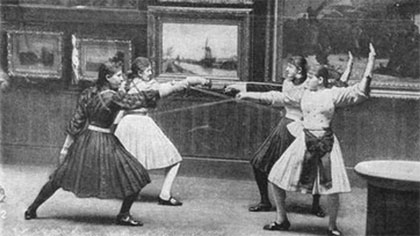 The Duel Was All Women, With No Men Involved
The Duel Was All Women, With No Men Involved
The duel between Princess Pauline and Countess Anastasia is known as the “emancipated duel.” That’s because the duel was not only fought between two women, but the women also had female seconds and a completely female medical staff to tend to their wounds. To stick with the noble theme, the seconds were Princess Schwarzenberg and Countess Kinsky, and the presiding doctor was Baroness Lubinska, who had a degree in medicine.
Dueling had always been connected with honor – which meant masculine honor. Sometimes men fought duels over women’s honor, if a sister or wife was dishonored, but even that was closely linked with male authority. It was shocking for a duel to feature only women. In fact, news of the duel quickly spread across Europe, with the Pall Mall Gazette running a story with the headline “Report of a Duel Between Two Ladies.”
• Photo: Wellcome Images / Wikimedia Commons / CC-BY-4.0
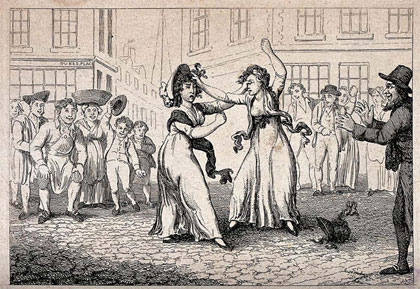 The Duel Was A Refined Affair, Not A Common Street Brawl
The Duel Was A Refined Affair, Not A Common Street Brawl
The topless duel was a refined affair. Princess Pauline von Metternich had a reputation across Europe for her fashionable taste and elite friends. She was best friends with Empress Eugenie, France’s last reigning empress. And Princess Pauline was also famous for her fashion sense. She grew tired of the enormous crinoline dresses popular in the 1860s and helped change the trend by wearing a fitted dress with a train. Pauline also helped make the German composer Richard Wagner famous, got haute couture off the ground, and was known to smoke cigars.
Everything Princess Pauline did was chic – and so was her duel. This wasn’t a common street brawl fought between two women trying to rip out each other’s hair. The duel was a refined affair, fought without anger or intense passion. And both women agreed to abide by the outcome. The story even made it all the way around the world, where the Los Angeles Times reported, “It was a real fight, and both were wounded – no hair pulling or plain scratching, but a duel with rapiers.”
• Photo: Library of Congress / Wikimedia Commons / Public Domain
 The Duel Was Fought Over Flower Arrangements
The Duel Was Fought Over Flower Arrangements
Duels were considered serious affairs, but the cause was not always serious. In 1892, both Princess Pauline and Countess Anastasia held positions on the board of the Vienna Musical and Theatrical Exhibition. And they apparently disagreed on the exhibition – the duel was reportedly over flower arrangements. But the story is more All About Eve than catfight.
By the 1890s, Princess Pauline was in her 50s, and Countess Anastasia was the new up-and-coming woman on the Vienna social scene. According to a British women’s magazine, Countess Anastasia was an ambitious young woman, “young enough to be the daughter of her rival [Princess Pauline].” And while Princess Pauline was in mourning over the death of her husband, Countess Anastasia “has come more to the front than ever and has been most indefatigable” – or, in modern language, Anastasia was stealing Pauline’s position. No wonder the women came to blows.
• Photo: Rama / Wikimedia Commons / CC-BY-SA-2.0-FR
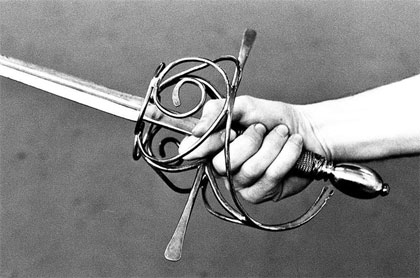 The Noblewomen Chose To Fight With Rapiers, Europe’s Oldest Dueling Sword
The Noblewomen Chose To Fight With Rapiers, Europe’s Oldest Dueling Sword
The weapon of choice for the topless duel was a rapier. Rapiers were not battle weapons – in fact, the blade’s sides were almost edgeless, because rapiers were intended for quick stabs. As weapons expert John Clements says, “Rapiers are generally thin, light, fast, and well-balanced thrusting swords intended for unarmored single-combat.”
The style of blade became popular in the 1500s, when Europe’s courtiers carried rapiers in case they needed to duel or deal with a back alley challenge. And in fact, the style went hand-in-hand with the rise of dueling.
The noblewomen apparently thought they were perfect for a duel to first blood, where the point was to draw blood rather than cause significant harm.
• Photo: YouTube.com
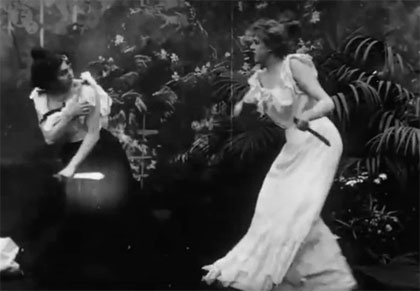 The Duel Was Fought Topless – For A Good Reason
The Duel Was Fought Topless – For A Good Reason
The duel between Princess Pauline and Countess Anastasia was fought topless. While it might seem like a strange choice for the women fighting the first emancipated duel to take off their tops, the women did it for a good reason.
As they were preparing to duel, another noblewoman, Baroness Lubinska, suggested that the women remove their tops. The baroness had a medical degree from a university in Poland, and she had first-hand experience with the dangers of infection. The princess and the countess did not intend to fight to the death – they chose to fight to first blood instead – so the baroness suggested removing their tops for safety. If the rapiers pushed a piece of dirty cloth into the wound, it could easily become infected, but if the blade only touched bare skin, the women would be safer.
On the baroness’s orders, the princess and the countess ordered their male servants to leave and then stripped to the waist to fight.
• Photo: Friedrich von Amerling / Wikimedia Commons / Public Domain
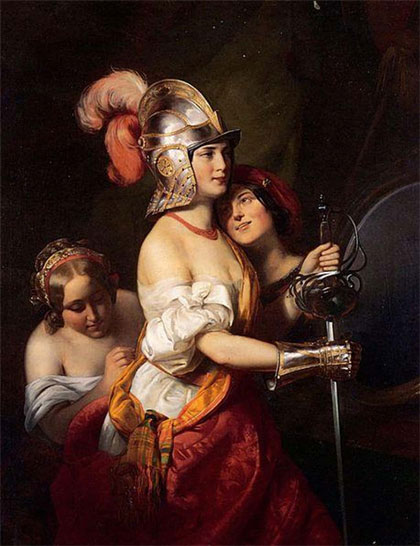 The Duel Went Three Rounds, Until The Princess Drew First Blood
The Duel Went Three Rounds, Until The Princess Drew First Blood
The princess and the countess met with rapiers to settle their dispute. As their female seconds and Baroness Lubinska watched, the topless women fought each other, swords flying, to a draw in the first round. The second round was the same. Neither woman could draw blood, which would signal the end of the duel and crown a winner.
But in the third round, both women struck a blow. Countess Anastasia managed to nick the princess’s nose, while Princess Pauline drew blood on the countess’s arm. The seconds examined the wounds and ruled that the princess was the victor. After the duel, the seconds advised the princess and the countess to “embrace, kiss, and make friends; which accordingly they did.”
• Photo: Hans Talhoffer / Wikimedia Commons / Public Domain
 Women Had A Long History Of Dueling
Women Had A Long History Of Dueling
Princess Pauline’s duel wasn’t the first fought between women. In fact, women had been fighting in duels for centuries by the time the princess and the countess came to blows. In 1467, Hans Talhoffer wrote a dueling manual explaining how women could fight in duels. But rather than women fighting other women, Talhoffer imagined that the women would fight men. To level the playing field, Talhoffer advised that the man should “stand in a hole up to his waist.” If the woman was able to drag the man out of the hole, she was considered victorious.
Dueling evolved a great deal between the 1400s and the 1890s. The emancipated duel proved that women could be just as refined (and powerful) as men, without changing any of the dueling rules.
• Photo: Illustrated American Pub. Co. / Wikimedia Commons / Public Domain
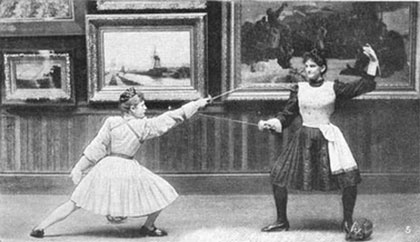 The Idea Of Women Fighting For Themselves Was New In The 19th Century
The Idea Of Women Fighting For Themselves Was New In The 19th Century
Dueling might have been centuries old by the 1890s, but women fighting other women in duels was still rare. In some earlier cases, women had asked men to fight duels on their behalf. For example, Séverine, a female journalist, asked a male colleague to fight for her to defend an article she had written. However, a movement in the late 19th century pushed “new women” to fight for themselves. Gisèle d’Estoc said that if a woman employed a male champion rather than taking up the sword herself, she was committing a “deed of inferiority.”
The duel between the princess and countess was understood in those terms. The noblewomen did not need men to fight their battles – nor did they need male seconds.
• Photo: Library of Congress / Wikimedia Commons / Public Domain
 The Emancipated Duel Struck A Blow For Women’s Rights
The Emancipated Duel Struck A Blow For Women’s Rights
The late 1800s were a heavy time for women’s rights in Europe, and the “emancipated duel” was understood through that lens. Across Europe, the women’s suffrage movement demanded the right to vote, but this push for rights was seen as threatening to the old order. As Europe’s most famous feminist, Mary Wollstonecraft, argued in A Vindication of the Rights of Women, “I do not wish [women] to have power over men; but over themselves.”
Many leaders of the women’s right movement were well-off women, either from the aristocracy or the upper middle class. The duel’s emancipated nature – using only women as seconds and for medical purposes – carried a strong message about women’s capabilities. And yet the same message signaled a terrifying new reality to men of the old order who feared women taking control.
• Photo: Wellcome Images / Wikimedia Commons / CC-BY-4.0
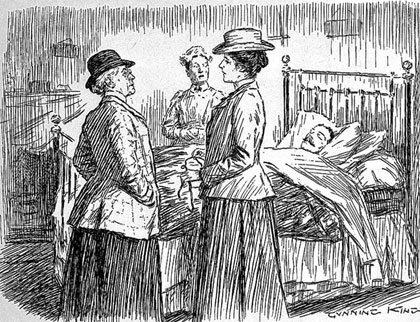 The Baroness Was A Rare Sight – She Was A Female Doctor
The Baroness Was A Rare Sight – She Was A Female Doctor
Female doctors were still very uncommon in the 1890s. Many places blocked women from attending medical school at all. Some women worked very hard to gain an education. A British army surgeon named James Barry practiced medicine for over 40 years before it was revealed that Barry was actually Margaret Ann Bulkley masquerading as a man. In fact, it wasn’t until after World War I when the shortage of doctors was particularly dangerous that the majority of medical schools began admitting women.
And Baroness Lubinska, the woman who oversaw the duel and tended to the fighters’ wounds, wasn’t just ahead of her time because she graduated from medical school.
She was also an early supporter of germ theory, which argued that germs could cause deadly infections.
• Photo: Johann Ludwig Bleuler / Wikimedia Commons / Public Domain
 The Women Traveled All The Way To Liechtenstein For Their Duel
The Women Traveled All The Way To Liechtenstein For Their Duel
Dueling wasn’t always legal – in fact, by the end of the 19th century, a number of countries had passed strict anti-dueling laws. Even at the beginning of the century, when Aaron Burr shot and killed Alexander Hamilton in a duel, Burr was charged with murder by New York and New Jersey.
So the noblewomen knew they had to be careful about choosing the right location for their duel. As a result, they traveled from Austria to Vaduz, Liechtenstein, to hold their duel. Liechtenstein was an independent principality that had recently offered sanctuary to the pope if he ever had to flee the Vatican. Perhaps the princess and the countess knew that the small territory would overlook an illegal duel by two Austrian noblewomen.
• Photo: Victor Marie Picot / Wikimedia Commons / Public Domain
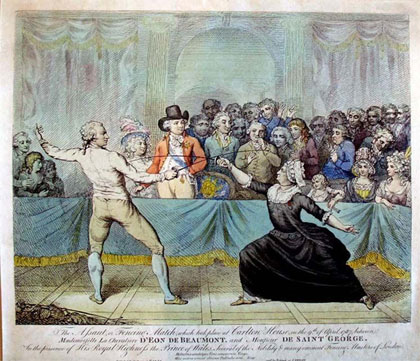 The Topless Duel Was Fought At The End Of The Era Of Dueling
The Topless Duel Was Fought At The End Of The Era Of Dueling
The topless duel was one of the last major duels in an era that stretched for centuries. The end of the dueling era was partially a response to the bloody wars of the 19th and early 20th centuries. As new battlefield technologies like machine guns and chemical weapons destroyed entire generations of young men, duels suddenly seemed wasteful.
The decline of the aristocracy also changed the nature of dueling. As social position became more connected with wealth and less with honor or family name, men were less likely to challenge each other to duels.
Or perhaps once women showed that even duels could be emancipated, men no longer wanted to participate.
ranker.com
























